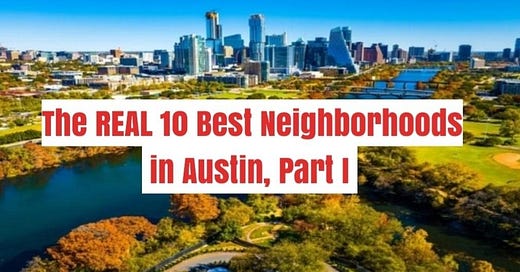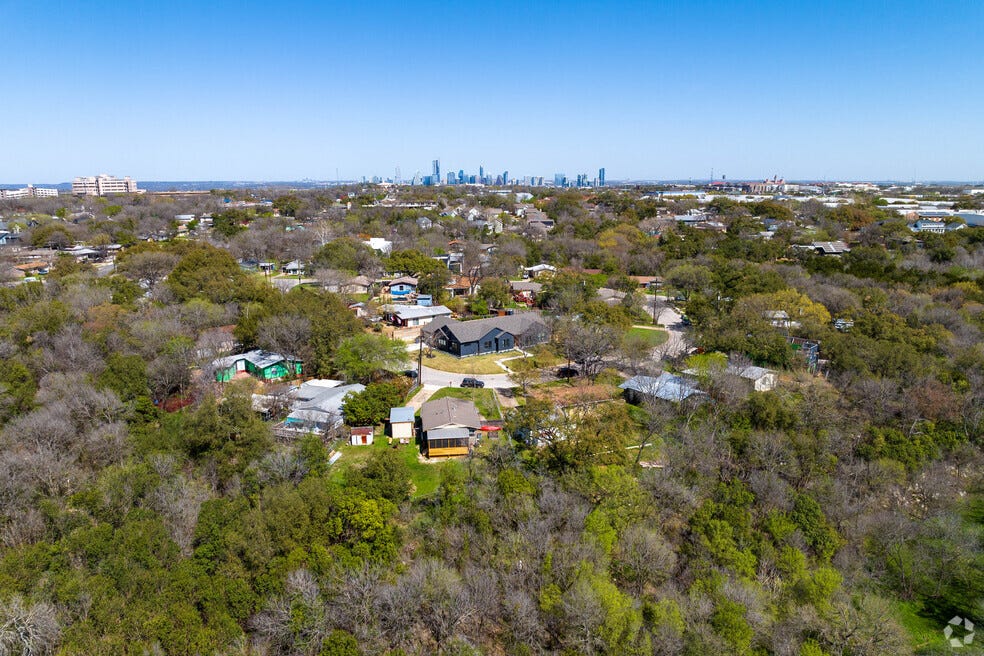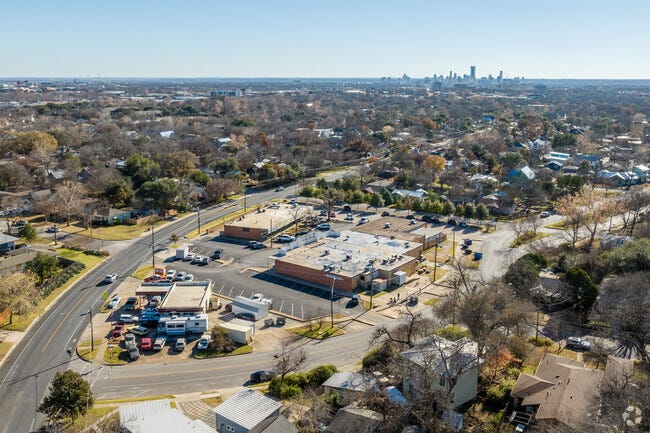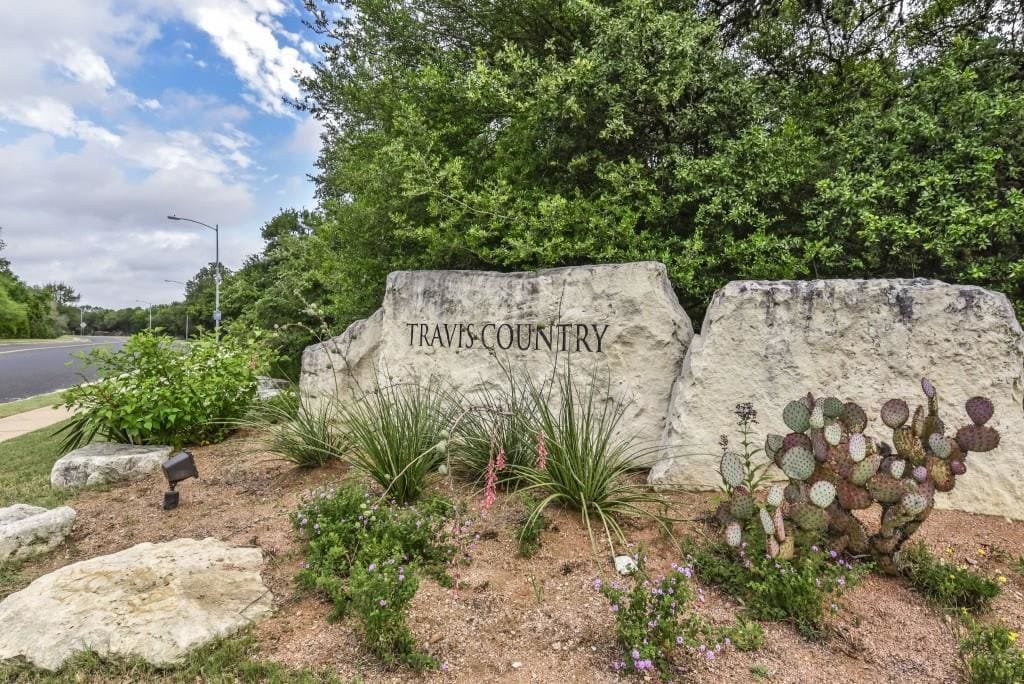The REAL 10 Best Neighborhoods in Austin, Part I
This is what happens when I stop being polite and start getting real
I’m more than happy to admit at the top that there are already a hefty bevy of “Best Austin Neighborhoods” pieces out there. In fact, it has turned into a bit of a cottage industry here the last couple of decades.
But what will separate what you’re about to read from the current noise is the fact that I’m coming at it with very little baggage, meaning I’m not a Realtor and/or I don’t need to sell ads. Yes, I have my biases as anyone does (being ultra expensive REALLY hurts you in these rankings, so (spoiler) you won’t be seeing Westlake), but I really don’t give a hot shit what anyone thinks about it. I also won’t be trying to sound trendy or cool or like I’m yearning to wow you with my picks, and I’m certainly not concerned about laying the foundation for your interest in a hip condo I’ll want to show you later for a tasty commission.
So, what is my formula for this? That’s the fun of it—it’s a vibe instead of some purportedly scientific evergreening of something that is inherently subjective. I’ll tip my evaluative hand in the text of each pick, but it sure as hell isn’t calculus. It’s my secret sauce. Let go, let Mo.
With all that said, here’s Part I. Part II will drop soon.
South Manchaca: Anyone time traveling from, say, 1999 will likely be shocked seeing this kicking off my list. But it’s 2025, buddy, and this area is now a really solid place to live that checks a lot of boxes (and you’re apparently allowed to live there even if you don’t pronounce it correctly). It features a relatively affordable, dense urban/suburban vibe and is conveniently located, adjacent to both South Lamar and Sunset Valley with easy access to downtown, MoPac and I-35. You will also find outstanding restaurants, bars, and food trucks, and the housing costs are on the reasonable end of 2025 Austin. It’s fair to say that the area’s scores on crime aren’t as sterling as most others on this list, but it appears to be getting better. For all y’all with kids, the public schools available to the area include Covington, Crockett, Ann Richards, and LASA. (Median Home Price: $566,000.)
Mueller: Once an airport, this interesting place that somehow feels both far from and close to everything in Austin comes with a solid park/walking path (with water!) and a decent outdoor mall baked in, so it’s a rare hood that actually has visitors. While it never seems overwhelming like The Domain, it can be fairly said that it lacks a bit of the traditional neighborhood feel given its emphasis on restaurants and retail. It’s most definitely not cheap, but living there might not put you in selling kidney land. There’s a good mix of residents with/without kids, and the Maplewood/Lamar/McCallum AISD lineup is really solid. But if you’re looking for Westlake level schools, this place (and my whole list, really) is probably going to disappoint you. (Median Home Price: $782,000.)
Crestview: For all y’all who want to live in Central Austin, but are floored by the sticker shock of most places, here’s a very nice enclave bordered by Burnet, Anderson, and N. Lamar that might just work for you given its relatively chill and “cool adjacent” urban-suburban vibe, including being on our lone commuter train line, which is a wild statistical win. And, if you’re not in the market for a home, the rent isn’t insane like it is in some surrounding areas. The public schools here are also really solid with the same Lamar/McCallum AISD feeder as Mueller (Brentwood is the Elementary School). Bonus: unlike some of the cohorts on this list, Crestview actually has a bit of history. It may not carry the same eyeball appeal or cache as the hoods to its south and west, but it has a booming general store in 2025, and that ain’t nothing. (Median Home Price: $629,612.)
Travis Country: This may be the first stunner on here, but hear me out. It has a really nice mix or urban and bucolic, good amenities (parks and a pool), is close to downtown, and, while a bit pricey (Note: the average home price represents a substantially larger house compared to other places), it isn’t outlandishly expensive like some of the place to its north. Yes, it’s a planned community, but it doesn’t have a cookie cutter vibe that those types of places often suffer from. The evolution of Southwest Parkway has made the traffic here more problematic in recent years (it can take a frustrating 15 minutes just to hop on MoPac during rush hour these days), but it’s still tantalizingly adjacent to so many cool things like Zilker Park and Barton Springs that it’s a small price to pay for many. Oak Hill/O. Henry/Austin High is the AISD feeder network, and all are regarded as very good schools. (Median Home Price: $811,000.)
East Austin: In 2025 this is, in reality, several different (and often wildly so) sub-neighborhoods, but for purposes of this exercise I’m going to treat them together. An interesting mix of Austin natives and eager newbies spanning a wide array of racial and socioeconomic demographics, it has long been under fire as representing the front lines of the city’s gentrification battle. But I’m not here to judge how that has unfolded. That’s a totally different, and very worthwhile, discussion. I’m simply stating that East Austin is a really cool and rapidly evolving area where you might be able to make your stand. Featuring incredible food, bars, parks, and shopping options, as well as interesting architecture and a rich, diverse history, it really is a 2025 laboratory for our city. Yes, it’s I-35 adjacent, but I’ll try not to hold that against it. The AISD school options here are many and, depending on what sources you rely on, are not considered as sterling as other places on this list. But there are some objectively good ones, including Kealing, Garcia Academy, LASA, and LBJ Early College. (Median Home Price: $515,000.)
Part II of this list will be posted soon!










Excellent, man